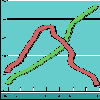 |
 |
Top-tier Growth Paradigms
By : Jim Pinto, All businesses go through five stages of growth. The final phase, growth to $10 billion and beyond, is not well understood. In relatively slow growth industrial market, companies can only grow through mergers, acquisitions and diversification. Some companies get stuck in the wrong paradigm.
September 2008
|
 Business go through five stages of growth. Each stage needs different management structures and strategies to optimize business during that phase of development. It is important to understand why certain management styles, organizational structures and coordination mechanisms work, and do not work, at each stage.
Business go through five stages of growth. Each stage needs different management structures and strategies to optimize business during that phase of development. It is important to understand why certain management styles, organizational structures and coordination mechanisms work, and do not work, at each stage.
Here are the characteristics that describe each growth phase or paradigm:
Grow or dieGrowth by acquisition seems the only alternative. But acquisitions are fraught with problems. It's very difficult to install good management in an acquired company, to stimulate growth and maintain earnings. Small acquisitions ($10 million to $50 million) are relatively doable, without much risk. The larger the acquisition, the more the danger; one slip and earnings may collapse, causing the acquirer's stock to dive, and making it a buyout target for much larger organizations. Primarily for this reason, the $1 billion to $5 billion automation majors are vulnerable. They must seek larger consolidations, or stagnate.Most of the global automation leaders are parts of companies that are all well beyond $20 billion in global sales. At about $114 billion, Siemens is well diversified - energy, industrial and healthcare. Honeywell is $36 billion and Process Systems represents less than 10 percent of total revenue. Emerson is $25 billion, with Emerson Process Management about 25 percent of the total. At $33 billion, ABB has eliminated too-broad diversification, but is split between automation and power, with globalization that serves it well. The top-tier independents, Rockwell Automation and Invensys, have eliminated diversification over the past few years in order to focus on automation. In a stable-to-declining market, that is the wrong paradigm. Both are stuck seeking organic growth at a company size that makes that difficult. To grow beyond $5 billion and reach the $10 billion-plus range, "bet-the-farm" decisions must be made. In order to achieve the growth that markets expect, they'll either make a major acquisition or themselves be acquired. 
|
 Pinto's Points How to win in the Automation Business Go shopping - books, electronics, CD/DVD Selected advertising coming here. Contact Jim Pinto for rates. |
Return to Index of all JimPinto Writings

 Return to JimPinto.com HomePage
Return to JimPinto.com HomePage
If you have ideas or suggestions to improve this site, contact: webmaster@jimpinto.com
Copyright 2006 : Jim Pinto, San Diego, CA, USA
